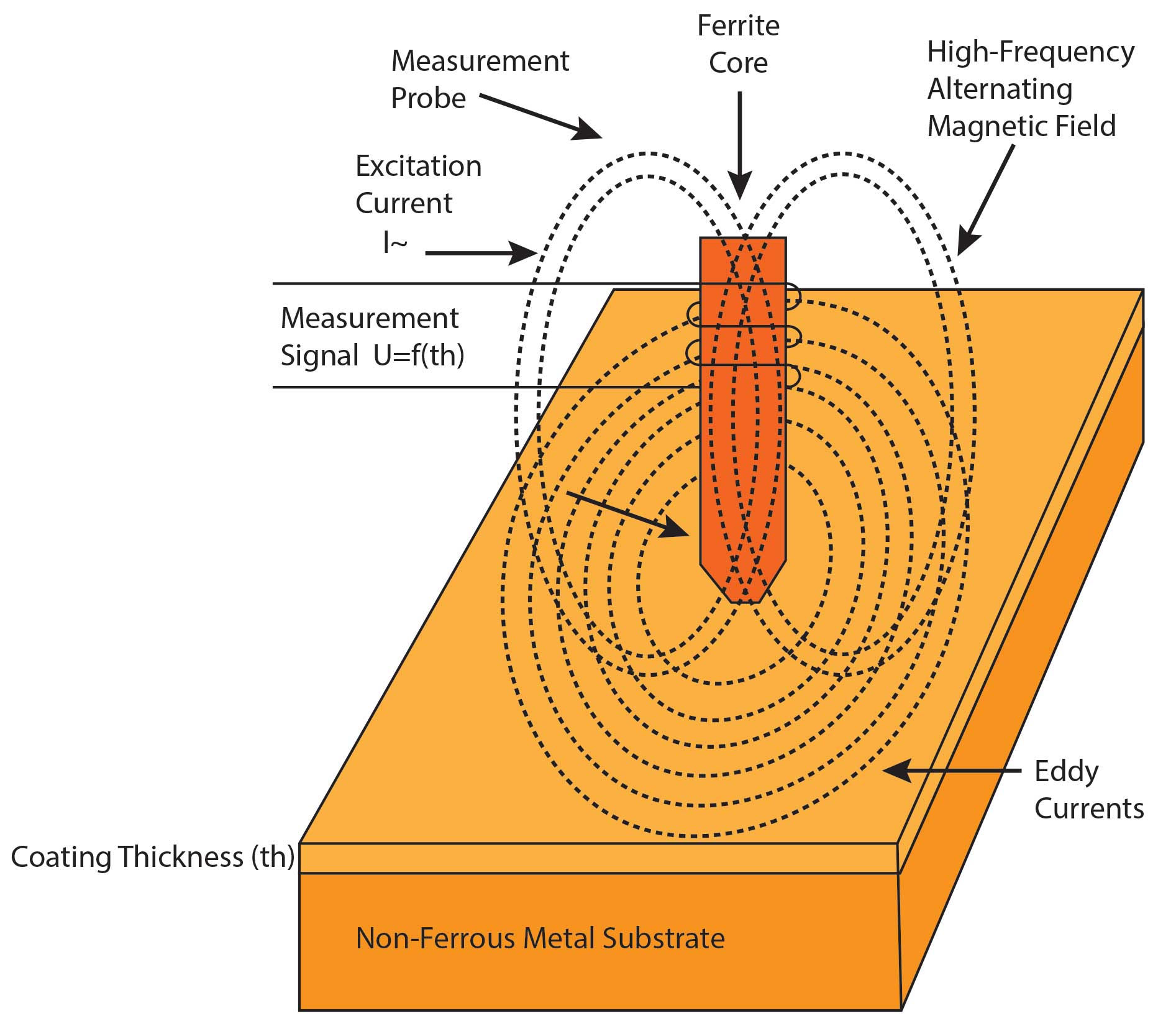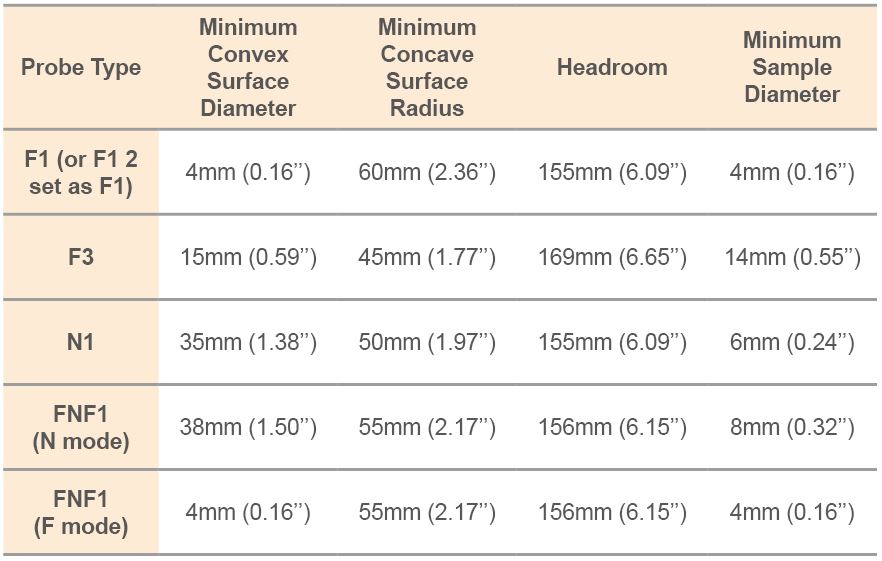
Electronic Coating Thickness Gauges
Type 2 Gauge: An electronic instrument that uses electronic circuitry and the magnetic induction to convert a reference signal into a coating thickness reading. It also uses the principles of the Hall Effect or the eddy current, or both, or a combination of magnetic and eddy current principles.
Electronic coating thickness instruments can be used to measure coating thickness on metallic substrates. Commonly used techniques are electromagnetic induction and eddy currents. Electromagnetic induction is used for magnetic substrates such as ferrous materials, whilst the eddy current method is employed when the substrate is non-ferrous.
Electromagnetic Induction
A voltage is produced when a magnet is moved into a coil of wire. This process is called induction. The direction of the induced voltage is reversed when the magnet is moved out of the coil again. This alternating magnetic field is used to measure coating thickness. A coil of fine wire wound around a magnetic core is used to produce a magnetic field. A second coil of wire detects changes in magnetic flux.
The magnetic flux density at the surface of a magnetic probe changes as it nears a steel surface. The distance from the steel substrate affects the magnitude of the flux density at the probe surface. So by measuring flux density, the coating thickness can be determined.
Eddy Current
In the case of the eddy current principle, a single coil probe is used with a relatively high frequency signal, several mega-hertz, to generate an alternating field in the non-ferrous metal under the coating. The field causes eddy currents to circulate in the substrate, which, in turn, have magnetic fields. These fields influence the probe and cause changes to the electrical impedance of the coil. These changes are dependent on the coating thickness.

The amplitude sensitive eddy current method is used to measure non-conductive coatings on non-magnetic metallic substrates. The phase sensitive eddy current method (phase shift) is used to measure non-magnetic coatings on either metallic or non-metallic substrates. This is especially the case if the coating is a painted metallic coating or a non-contact measurement is required.
Further developments in technology have enabled instruments to combine technologies, such that they can measure accurately on both ferrous and non-ferrous substrates, automatically switching to facilitate the change.
The advantage of electronic gauges is the incredible accuracy. Gauges like the Elcometer 456 are accurate to +/- 2.5 µm or 1-3% (whichever is the greater) and can achieve up to 70 readings per minute. Few gauges exhibit greater accuracy than this, but the Elcometer 355, for example, using the same measurement methods, is accurate to +/- 1 µm. The accuracy, of course, is only as good as the calibration.
One point that should be noted with gauges using these two measurement principles of electromagnetic induction and eddy currents is the edge effect. How the flux lines flow around the edges of a substrate is significantly different from how they flow through the body of the material. The readings at the edge will therefore be different from the readings taken in the main body of the substrate. For this reason, Elcometer has a minimum sample diameter for each probe, half of which (the radius), gives the distance from an edge the probe must be for a correct reading.

X-Ray Fluorescence
The coating and the substrate material both produce X-ray fluorescence radiation, but the radiation emitted by the substrate loses energy (attenuated) by the coating. Various properties of the coating will determine how much energy the X-ray fluorescence radiation loses, especially coating thickness. There is, therefore, a link between the secondary emissions and the coating thickness.
The Hall Effect
The Hall Effect principle of measurement is a modification of magnetic induction technology. The Hall Effect measurement method is mostly used when measuring the thickness of plated nickel on a non-magnetic substrate. Plated nickel is slightly magnetic, as the nickel deposit becomes thicker, so the magnetic properties of the nickel coating will increase. The strength of the magnetism in the nickel coating can be calculated using a Hall Effect sensor in the probe.
A Hall Effect sensor is a specialised semiconductor which responds to changes in a magnetic field that appears across its surface as a current passes through it and thus the thickness of the coating can be determined.
Ultrasonic
Using basic measurement methods, coatings on non-metallic substrates may be measured. The coating is treated as a substrate and a simple material thickness measurement is taken which is the coating thickness.
Beta Backscatter
A beam of beta particles is directed through an aperture onto the coated component and some of these particles are reflected (backscattered) from the coating back through the aperture, penetrating the window of a Geiger Muller tube.
The inert gas in the tube (often helium or argon) ionizes causing a discharge across the tube electrodes. This creates a pulse which is counted by an electronic counter and then translated into a coating thickness. If the coating thickness increases then the backscatter rate increases. The change in the rate of beta particles scattered is a measure of coating thickness.
This method is used for measuring gold, silver and tin on electronic components; decorative plating on plumbing fixtures and vapour-deposited coatings on ceramics and glass. Oil or lubricant coatings on metals can also be measured using this method.
Need Support?
If you'd like more information about the different types of electronic coating thickness instruments available to you, explore our different ranges here.
Alternatively, if you already own electronic coating thickness instruments and would like more information about the different techniques to take coating readings, get in touch by visiting our contact us page.
